The Palmetto Tree Service Difference
At Palmetto Tree Service, we believe that trees make the world a much more pleasant place to live. They provide us with refreshing shade, verdant beauty, cool shade, and emergency shelter. They add personality to our homes, raise our property values, and give us clean air to breathe. When your home is well-manicured, with healthy trees, everyone around benefits. That's why, as arborists, we are passionate about providing our customers with dependable Lowcountry tree care.
We believe that honest prices, state-of-the-art equipment, friendly arborists, and good old-fashioned hard work set us apart from our competition. With years of experience serving homeowners in South Carolina, you can rest easy knowing every member of our team is committed to:
- Conducting themselves in a professional manner
- Providing you with top-notch tree care services
- Arriving at your property on time and ready to work hard
- Providing you with reasonable tree care service rates
- Exceeding expectations
- Utilizing safe, time-tested techniques when trimming, pruning, or removing your trees and shrubs
- Friendly, helpful customer service
Our customers mean the world to us. When you hire our company for tree services in cityname, we take that responsibility seriously. No matter the size of your project, our team will always treat your home like it is our own. Plus, you won't ever have to worry about sneaky hidden fees or outrageous pricing. We believe every homeowner deserves access to affordable tree services!
Whether your home has overgrown trees that need trimming or you have unsightly stumps that require grinding, we're here to handle it all. Curious what kind of tree care we provide to homeowners in The Palmetto State?
Call Us
 843-345-0579
843-345-0579
Our Services
Services Area
Eco-Responsible Tree Removal in Johns Island, SC
We have removed thousands of trees over the years. However, we never recommend tree removal if it's not warranted. Some South Carolina tree service companies tend to remove trees when they should be saved or simply pruned. Others go the opposite direction and never recommend tree removal.
Unlike other companies, our arborists make educated recommendations based on experience, your trees, and your needs. We make the right call for you - not for us. If disease, destruction of foundation, or other circumstances necessitate tree removal, rest assured we're recommending it for a reason.
Benefits of Tree Removal
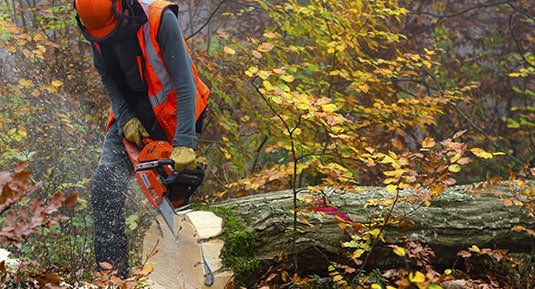

Though we never recommend this service unless it's needed, tree removal is often the only way to protect your property and family. When done properly, removing trees from your yard can have numerous benefits.

Prevent Damage to Your Foundation
When the roots of a tree spread and grow, they often damage concrete structures, like your home's foundation or driveway. This unsightly, unsafe situation is preventable with careful tree removal.

More Yard Space
If you've got to remove trees, you might as well make use of the space. Removing trees from your yard frees up space for fun, useful additions to your home firepits and pools. Some examples that we've seen from clients include removing more free space to plant vegetables and flowers and even room to build a new basketball court.

Enhanced Views
Another benefit of tree removal is that you can create a better view for your home, both inside and out. If you have unhealthy trees blocking the view of your property, removing the tree could be a solution. On the other side of the coin, you might want the exterior view of your home to remain intact and unobstructed by trees.
Tree Trimming in Johns Island, SC
Have you noticed your favorite tree growing strangely? Are your trees so overgrown that it's making your home look like vagrants live there? Are the trees around your property weighed down by dead, dangerous branches? If you answered yes to any of those scenarios, Palmetto Tree Service has a solution to your problem.
Most folks don't know that trees respond to their environment. When trees aren't cared for, they can cause unwanted problems for the homeowner. Issues like overgrowth aren't just ugly - it's a potential safety hazard for your home and family. To prevent these problems from plaguing your property, it's important to keep your trees pruned and trimmed.
Our pruning and trimming have been described as "artistry" by our customers and are performed by highly skilled tree climbers per the Society of Arboriculture standards. Trimming procedures such as view enhancement and crown raising boosts curb appeal and open up obscured views. Proper pruning can also help establish your tree's structural integrity, which helps keep them planted firmly even in South Carolina wind gusts.
Because every shrub and tree is different, we approach our tree trimming projects with a detailed plan of action. That plan starts with our team of professional tree trimmers visiting your home. Once we see what kind of trees we'll be pruning or trimming, we'll put together an actionable plan which we'll share with you. As tree care specialists, we always account for unique variables like your tree's species and where they're located in your yard.
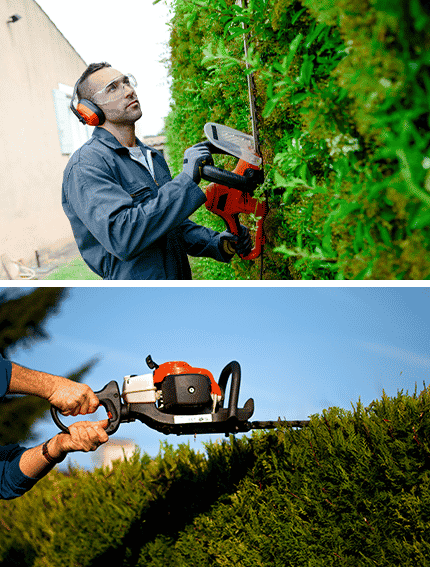
Benefits of Tree Trimming
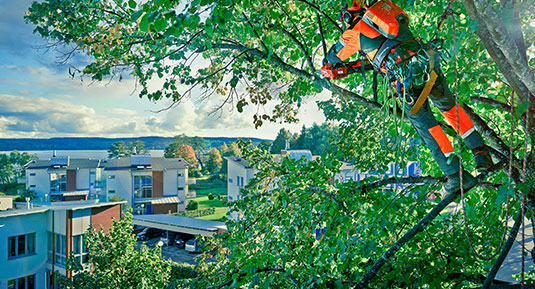
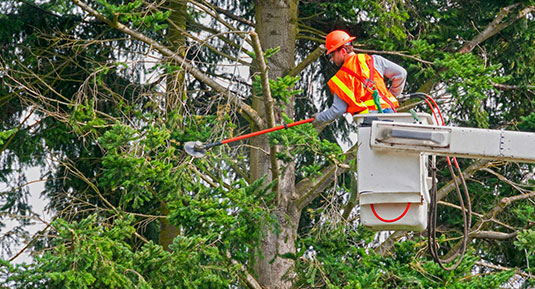
For some folks, tree trimming seems like a minor detail in the grand scheme of homeownership. It can be tedious, but keeping your trees trimmed and well-maintained is more important than you might think. Below are just a few of the many benefits of keeping your trees and shrubs trimmed:

Tree Health
Part of the Palmetto Tree Service pruning and trimming process includes the removal of damaged, broken, dead, and diseased branches. When ignored, these dead and dying branches grow harmful fungi that can decimate the trees around your home or business. Removing these branches can help keep your trees healthy. Tree trimming also allows the sun and air to reach your trees, further helping to maintain their health.

Safety
As proud residents of South Carolina, we know how scary lightning storms and hurricanes are. Strong winds from these natural disasters result in fallen branches and uprooted trees. South Carolina's storm season is a serious concern for homeowners, especially those with tree-lined driveways, rec areas, and walking paths. When you trust Palmetto Tree Service, you're actually storm-proofing your home. If you have low-hanging limbs near home, pruning provides more safety and overhead clearance. That way, you don't have a panic attack every time the skies open up.

Aesthetics
Nobody likes the looks of a dying, disheveled tree. Tree trimming improves the general appearance of your tree and makes your whole yard and home look better. Tree trimming also helps prevent branches from intertwining with one another.

Developmental Tree Trimming
Pruning younger trees is crucial for their health as they age. This vital tree service in Johns Island keeps young trees appealing and helps promote optimal branch structure.
Types of Tree Trimming
Not all tree trimming services from Palmetto Tree are the same. Our experts specialize in many trimming services, so you get the right kind of trim for your needs. Our team understands that even the slightest mistake can permanently affect your yard and trees. That's why we approach every project with precision and expertise.
Crown Reduction: When your trees age without proper care, they can develop too many branches on their interior. Trees like this give great shade, but too much is not a good sign. That's where crown reduction trimming comes in. By reducing the density of your tree's crown, our tree care experts improve its growth rate and health. Crown density reduction also promotes a longer lifespan and a more beautiful appearance.

Storm Prep and Cleanup: Trimming and pruning procedures like removing dead wood and thinning crowns should be done before a major storm hits. Reducing branches and leaves lessens the force that wind gusts have and helps minimize the chances of trees falling. If a storm does damage your land, Palmetto Tree Service has the team and tools to help. Having recently worked Hurricanes Charlie, Ivan, Wilma, Katrina, Ike, Irene, Florence, Dorian, and even Sandy, Palmetto Tree Service has vast experience with twisted and fallen trees. We protect your property from further damage and safely remove lumber from damaged structures.
Other tree trimming services that Palmetto Tree Service offers include:
- Hazardous Tree Assessments
- Shrub Trimming
- Pruning
- Cabling
- Bracing
- Corrective Trimming
Contact Us
Free EstimateStump Grinding in Johns Island, SC
For most property owners, removing a tree can seem like a major project. While that notion certainly isn't wrong, tree removal is more straightforward and often easier than trying to remove an unsightly stump from your yard. Have you ever wondered why you see so many yards with stumps dotted around the land? It's because they're tough to remove. That is why Palmetto Tree Service offers stump removal services in South Carolina.
Our skilled stump grinders bring a depth of knowledge and modern tools to every project we approach. Available for any tree removal project, our fast, efficient grinding machines ensure stumps are 6-8 inches below grade. That way, you can plant your favorite bushes and shrubs where your stump used to be.
Our stump grinding and removal efforts don't just make your yard look great. They also save you time, money, and can prevent injuries. There's a time and place for DIY yard work, but stump removal isn't one of them. Going the "DIY" route can take weeks, even if you work an hour or two every day. There's also the issue of operating heavy machinery on your own, which is dangerous and costly. For these reasons alone, it's best to trust professional stump grinders to remove your tree stumps safely.

Benefits of Stump Removal in Johns Island, SC
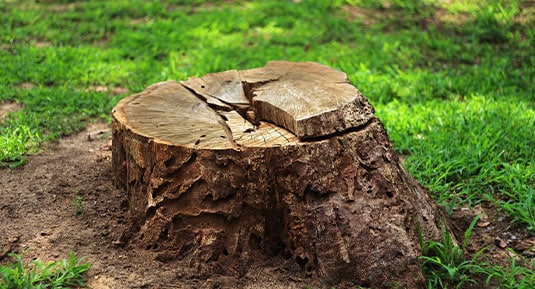


Pest Prevention
Tree stumps are notorious for harboring harmful pests that can ruin your property. We're talking ants, termites, carpenter bees, and other wood borers. If you've noticed an uptick in pests around your home, call Palmetto Tree Service for a quote on our stump removal. You could be killing two birds with one stone.

Eliminate Unwanted Growth
When you leave a tree stump in your yard, there's a good chance you could experience unwanted tree growth. These new growths cause clusters of small trees to grow at the base of your stump. This isn't only unsightly - it can kill nearby plants because the more recent growths hoard water and nutrients to themselves.

Better Looking Yard
If you're a homeowner who loves beautiful landscaping, well-sculpted hedges, and a neat law, you will love our stump removal services. Not just for the weight off your chest but for your home's enhanced curb appeal and resale value. This point is extra pertinent if you're going to sell your home soon.

More Space
If your yard is small, even one stump can affect your usable space. If you spend a lot of time playing sports or just enjoying your yard space, stump removal is a huge help. After all, nobody wants to toss a football if there are old stumps you've got to avoid. With their complicated root systems, stumps also take up considerable space below ground. Stump removal gives your family the space needed to grow vegies, plant flowers, erect water features, and more.

Reduce Headaches
Is stump removal impossible for non-professionals? Sure, in theory. You could take spend hours researching the best ways to remove stumps. You could go to your hardware store, rent a powerful stump grinder, and risk your safety trying to run it without training. You could spend every minute of your free time grinding the stump down. Or, you could work with a trustworthy stump removal company with trained professionals, as you'll find at Palmetto Tree Service.
Your Premier Tree Service Company in South Carolina
With years of experience, it's no wonder why so many South Carolina natives choose Palmetto Tree Service over the competition. Clients love us because we exceed expectations with a smile - no if's, and's, or but's.
Our commitment to superior service isn't a gimmick; it's a year-round promise. When you choose Palmetto Tree, you'll benefit from:
- Professional advice and expertise
- Seasoned, friendly, hardworking tree care experts
- Efficient, effective tree care services
- Competitive pricing
Ready to get started? We're ready to help! Give us a call to learn more about our tree care services and to schedule your first appointment today.
 843-345-0579
843-345-0579
Free Consultation
Latest News in Johns Island, SC
$277M hospital proposed for Johns Island
Ross Nortonhttps://charlestonbusiness.com/277m-hospital-proposed-for-johns-island/
Trident Medical Center has submitted a Certificate of Need to the South Carolina Department of Health and Environmental Control to build a $277 million hospital on Johns Island. The application is for a 50-bed acute care hospital between Maybank Highway and Cane Slash Road, across from the Live Oak Square development.Projections for Johns Island Hospital show that within the first three years it will create nearly 300 jobs, contribute $10 million in non-income taxes to support the community and pay $70 million in salaries, wages and b...
Trident Medical Center has submitted a Certificate of Need to the South Carolina Department of Health and Environmental Control to build a $277 million hospital on Johns Island. The application is for a 50-bed acute care hospital between Maybank Highway and Cane Slash Road, across from the Live Oak Square development.
Projections for Johns Island Hospital show that within the first three years it will create nearly 300 jobs, contribute $10 million in non-income taxes to support the community and pay $70 million in salaries, wages and benefits, the organization said in a release.
“We are excited to continue making medical care more accessible to residents in our historically underserved communities,” Trident Health President and CEO Christina Oh said in the news release. “Currently on Johns Island and neighboring communities, it can take residents 30 to 45 minutes to drive to their nearest hospital, and often longer in heavy traffic and inclement weather. Our goal is to increase access to timely, high quality and affordable health care services.”
Trident Medical Center’s chief of the medical staff and medical director of emergency services, Dr. Scott Hayes, said he sees firsthand the results of delayed care.
“For residents who live far from emergency medical care and who may be experiencing a medical emergency like a heart attack or a stroke, minutes can mean the difference between life and death,” he said in the news release. “Access to care close to home is critical, especially in areas like Johns Island and the surrounding communities, that have frequent traffic delays.”
Trident Health surgeon Dr. Thomas Litton, who lived on Johns Island for 20 years and recently moved from there largely due to increasing traffic congestion and limited access routes off the island, said, “The rapid population growth and development of Johns Island, as well as its role as the sole gateway to Kiawah, Seabrook and Wadmalaw Islands, has created a strong need for a full-service hospital in the area. Residents on those islands have never had a full-service hospital. Trident’s hospital on Johns Island and their freestanding ER on James Island will greatly improve residents’ access to much-needed medical care.”
Johns Island Hospital will be located seven miles from James Island Emergency, Trident’s new freestanding ER at 945 Folly Road, Charleston, that will open in the next few weeks.
Plans call for Johns Island Hospital to have 50 beds with space to expand to 150 beds, 40 medical/surgical/stepdown beds, 10 ICU beds, 20 ER rooms, four operating rooms, two endoscopy suites and a cardiac catheterization lab. The hospital also would have two CT scanners, an MRI, two diagnostic radiology suites and a fluoroscopy room.
In addition to the hospital, services would include medical offices for primary care and specialists as well as outpatient imaging and support such as breast imaging, rehabilitation and other outpatient therapy services.
“From our first discussions about building a hospital on Johns Island, we have been committed to creating a thoughtful plan that preserves the natural beauty of Johns Island,” Oh said in the release. “We will honor the strong Gullah Geechee cultures of the community; we will partner with the areas’ community and businesses; and will promote the important and unique contributions of Johns Island’s agricultural community.”
The proposed Johns Island Hospital is in addition to nearly $140M in capital investments currently underway at Trident Health’s hospitals, Trident Medical Center and Summerville
Why this Johns Island parcel will be permanently protected
Jason Thomashttps://charlestonbusiness.com/why-this-johns-island-parcel-will-be-permanently-protected/
Listen to this articleThe Charleston County Aviation Authority and Lowcountry Land Trust have announced in a news release the permanent protection of a 90-acre site once threatened by development in the heart of Johns Island.The action comes after years of collaboration through the Johns Island Community Conservation Initiative, a partnership of The Center for Heirs’ Property Preservation, Coastal Conservation League, Lowcountry Land Trust, and Open Space Institute, a news release stated.Positioned at the mouth of ...
Listen to this article
The Charleston County Aviation Authority and Lowcountry Land Trust have announced in a news release the permanent protection of a 90-acre site once threatened by development in the heart of Johns Island.
The action comes after years of collaboration through the Johns Island Community Conservation Initiative, a partnership of The Center for Heirs’ Property Preservation, Coastal Conservation League, Lowcountry Land Trust, and Open Space Institute, a news release stated.
Positioned at the mouth of Burden Creek, only a few feet above sea level, and sitting along Charleston’s Urban Growth Boundary adjacent to the Charleston Executive Airport, Oakville-Burden Creek’s 90 acres were once marked for development, the release stated. Despite extensive discussion about the perils of developing flood-prone areas and vocal community opposition, zoning laws allowed for the construction of over 200 houses on the property, according to the release.
In 2021, Charleston County Aviation Authority purchased the land, and last month, the property was permanently protected under a conservation easement placed by Lowcountry Land Trust, the release stated. Funding for the purchase of the conservation easement was provided by South Carolina Conservation Bank and Charleston County Greenbelt Program.
“The protection of Oakville-Burden Creek represents the power of collective work and reinforces the integrity of Johns Island’s historical, natural, and rural heritage resources and guarantees that development will never threaten Burden Creek again,” said Ashley Demosthenes, president and CEO, Lowcountry Land Trust, in the release. “A broad base of partnerships and relationships truly made this effort possible.”
The property protection not only offers benefits for quality of life and conservation, but also it plays a role to ensure incompatible uses don’t occur immediately adjacent to an airport, according to the release.
“The Aviation Authority remains cognizant of the need to preserve the environment while at the same time allowing for development and growth,” said Elliott Summey, CEO and executive director, Charleston County Aviation Authority, in the release. “The greenspace north of the airport will enhance the protection of land allowing the Authority to potentially create a future runway within the airfield footprint, acting as a buffer zone for safety and operational purposes.”
Lowcountry Land Trust, which in the past has collaborated with entities such as Boeing, Volvo and the South Carolina Ports Authority, holds the conservation easement, according to the releaese.
The conservation easement comes at a critical moment as Johns Island’s agriculturally zoned farmland and forest properties, some close to Oakville-Burden Creek and the Urban Growth Boundary, are constantly threatened by development, the release stated.
“Permanent conservation of the open space along the edge of the Urban Growth Boundary helps stabilize traditional rural communities by preventing suburban sprawl and the associated increase in taxes and service fees,” Michelle Sinkler, special projects director for the Open Space Institute, said in the release.
Johns Island residents react to ‘Northern Pitchfork’ project plan
Meredith Blairhttps://www.live5news.com/2023/11/16/johns-island-residents-react-northern-pitchfork-project-plan/
JOHNS ISLAND, S.C. (WCSC) - Those who live on or travel through Johns Island say they have mixed feelings about a new road designed to connect Maybank Highway to two other roadways.Work is continuing on what is called the Northern Pitchfork, which will connect Maybank Highway to Fenwick Hall Allee and River Road. That work will require lane closures from 9 a.m. ...
JOHNS ISLAND, S.C. (WCSC) - Those who live on or travel through Johns Island say they have mixed feelings about a new road designed to connect Maybank Highway to two other roadways.
Work is continuing on what is called the Northern Pitchfork, which will connect Maybank Highway to Fenwick Hall Allee and River Road. That work will require lane closures from 9 a.m. to 2 p.m. on Friday on Maybank Highway at River Road.
Some residents are hopeful it can be part of a solution for what they say is horrendous traffic but others say it’s just a Band-Aid on a bullet wound.
There is also frustration surrounding the daytime lane closures for Friday, as residents believe it will be a nightmare, and the work should be done overnight instead.
Charleston County Construction Project Manager Sheila Parker said this has to get done in a specific window of time and they don’t want project delays. The new road is something the city and county have been working on bringing to life for years, with the goal of alleviating congestion and moving traffic along on the island.
“People coming off of James Island onto Johns Island using the Maybank Highway corridor will be able to take the Northern Pitchfork road and kind of bypass the Maybank Highway and River Road traffic light,” Parker explained
Byhira Thorn, who frequents the island often, said she thinks the new road will cause confusion for drivers, and it’s not addressing the root issue.
“I think another lane in general needs to be added,” Thorn said. “I mean, they did it with the bridge which was awesome, but they need to do it with the island. The island itself all around, roads need to be doubled for sure.”
Johns Island resident Kristin Nolan said she hopes this will help, but wishes it was done sooner.
“First of all, I think they should have thought about this before all of the building that went on and the extra light that was put here,” Nolan said. “I feel bad for people that go to James Island in the morning if Maybank and River are backed up for miles.”
Earlier this month, Charleston leaders said they are working on a $30-million project to improve traffic on Johns Island, part of which includes widening Maybank Highway to four lanes from River Road to the Stono River Bridge. But funding for that has yet to be nailed down and those plans are years away.
The construction on Friday is weather-dependent and drivers are asked to use caution while driving through the area.
Copyright 2023 WCSC. All rights reserved.
Charleston leaders plan $30M project to improve Johns Island traffic
Steven Ardaryhttps://www.live5news.com/2023/11/02/watch-live-city-charleston-officials-address-johns-island-traffic-improvements/
CHARLESTON, S.C. (WCSC) - Officials with the city of Charleston and Charleston County have announced a plan to address traffic concerns on Johns Island.Charleston Mayor John Tecklenburg said the plan is the result of collaboration between the city of Charleston and Charleston County and will tackle traffic flow problems at the intersection of Maybank Highway and River Road, portions of Maybank Highway and the northern and southern Pitchforks, Tecklenburg said.“Traffic congestion has been a huge issue coming and going on J...
CHARLESTON, S.C. (WCSC) - Officials with the city of Charleston and Charleston County have announced a plan to address traffic concerns on Johns Island.
Charleston Mayor John Tecklenburg said the plan is the result of collaboration between the city of Charleston and Charleston County and will tackle traffic flow problems at the intersection of Maybank Highway and River Road, portions of Maybank Highway and the northern and southern Pitchforks, Tecklenburg said.
“Traffic congestion has been a huge issue coming and going on Johns Island,” he said. “And it was accentuated when that traffic light got added down the street. And everyone came to the realization that we needed to go back and rethink what got done six or seven years ago, what’s been done since then and what can we do collectively and collaboratively to make it better and make improvements.”
The city and county laid out the main points of the plan:
“Pitchforks” means two new roads that will branch off of Maybank towards River.
“The current cost estimate sits somewhere between $25 and $30 million to do all of this,” Charleston County Councilmember Joe Boykin said.
Tecklenburg said the money will come from future sales tax and Department of Transportation funding and once permitted, will apply for federal funding.
The full construction funding will have to be identified and approved by both city and county councils, according to Tecklenburg.
The first goal for short-term, interim improvements to Maybank Highway are expected to be complete in the first quarter of 2024, Tecklenburg said.
Robby Lingenfelter who works on Johns Island said he’s hopeful about the project but still frustrated.
“They say that the northern pitchfork will be completed by the first quarter of 2024, that’s good,” he said. “Southern pitchfork they said will take years, so we’re still five to ten years from alleviating the issues we have now.”
He said the city and county have been meeting since June to address the traffic issues on Johns Island.
“It’s going to happen. We are committed to making that happen,” Tecklenburg said.
Some locals question the mayor’s timing.
“Hearing this press conference that is happening five days before an election, can’t help but notice that a lot of this was conceptual and funding for a lot of this isn’t even secured,” Logan Mcvey said. “So, this seems like more talk and a lot more traffic just sitting and waiting on stuff to happen.”
Tecklenburg’s response was that they needed enough vetting through engineers and design teams before the plans could be presented.
Charleston County Council member Jenny Huneycutt, Charleston City Council member Karl Brady and the city’s planning and traffic directors also attended the news conference.
WATCH THE CHARLESTON LEADERS ANNOUNCE THE JOHNS ISLAND TRAFFIC IMPROVEMENT PLAN BELOW
This is a developing story. Check back for updates.
Copyright 2023 WCSC. All rights reserved.
Debate surrounds proposed Johns Island medical village
Emily Johnsonhttps://www.live5news.com/2023/12/13/debate-surrounds-proposed-johns-island-medical-village/
JOHNS ISLAND, S.C. (WCSC) - Charleston County held a public hearing Tuesday night to discuss and hear from anyone interested in the development of a large medical village on Johns Island.The planned development, located between 4357 and 4365 Betsy Kerrison Parkway, called the Island Park Medical Village would take up more than 17 acres.The medical village has been a topic among residents of the islands for months now with polarizing opinions supporting and against the development.More than 30 people spoke during public c...
JOHNS ISLAND, S.C. (WCSC) - Charleston County held a public hearing Tuesday night to discuss and hear from anyone interested in the development of a large medical village on Johns Island.
The planned development, located between 4357 and 4365 Betsy Kerrison Parkway, called the Island Park Medical Village would take up more than 17 acres.
The medical village has been a topic among residents of the islands for months now with polarizing opinions supporting and against the development.
More than 30 people spoke during public comment and hundreds of letters were sent to the council in opposition.
RELATED: Neighbor worried about proposed development on Johns Island
Developers are requesting to rezone the land from low-density residential to large-scale medical office park with almost 160,000 maximum square feet of business space.
The medical village was proposed to Charleston County Planning Commission Members back on November 13 with all 7 members denying the zoning request.
Tuesday night, the questions raised included what types of medical options and concerns about traffic.
“We do agree that we need medical facilities, that we do need access,” Long-time Johns Island Resident, Tamara Butler, says. “My question is just what kinds of medical facilities are going to be there and what services are going to be provided.”
Almost 900 property owners on Kiawah Island were surveyed with 80% saying they are against the medical village and think the size of the project is too large.
“In this particular instance, the site of it, the location, the scope and the scale, feels out of character with the area of the island,” Lowcountry Land Trust President Ashley Demosthenes says.
However some community members want the development, sharing why the area needs accessible medical facilities closer to their homes.
“We lack health care. So, this project, the wellness village, actually helps alleviate a lot of that for us because now we’re going to go in a different direction,” Long-time Johns Island Resident, Jim Hart, says.
Developers say they have held meetings to hear from the community about what they want out of the project, and have reduced the project’s size by 25%.
“We care about the community. All we want to do is to provide a development that meets the needs of the people, to curtail the traffic and to allow people to have a choice,” project developer Jill Skerchek says.
With no action being taken, the developers will present the plan again in two weeks to the county council with any possible changes they make in the meantime.
Copyright 2023 WCSC. All rights reserved.
Disclaimer:



